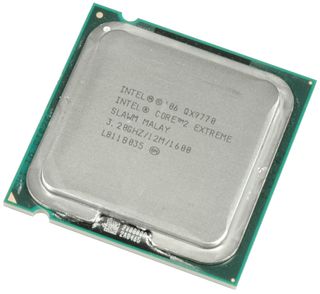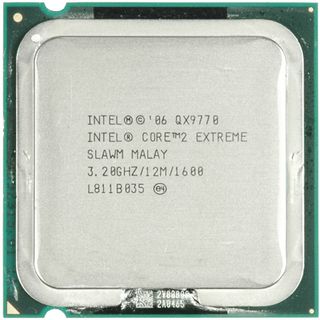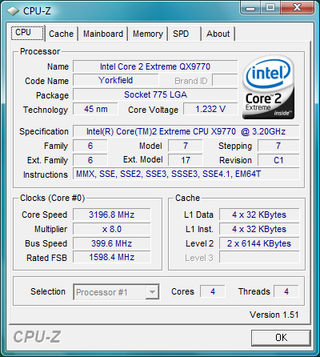DDR3 Memory Scaling: Intel's Core 2 Quad Examined
CPU: Intel Core 2 Extreme QX9770

We could have used several popular Core 2 Quad models, such as the Core 2 Quad Q9650, but we decided to go for flagship of Intel's Core 2 Quad family, the Core 2 Extreme QX9770.
This is the only Core 2 quad-core processor that runs at the maximum FSB1600 system speed, and it has a 3.2 GHz core clock, which is the same as the clock speed of the Phenom II X4 that we looked at previously. Using the fastest processor possible ensures that differences in memory performance become as visible as possible, and the QX9770 is the fastest Core 2 processor available for Socket 775.
There also is a Core 2 Extreme QX9775, which is based on the same core and clock speed. But that one is a Socket 771 processor for the Skulltrail platform, based on Xeon technology.

The Core 2 flagship is designed around two individual 45 nm Wolfdale die, each with 6 MB L2 cache, which combined adds up to 12 MB L2 cache. While the Skulltrail Core 2 Extreme processors are specified at a TDP of 150 W, the Socket 775-only QX9770 is limited to 136 W. That is still 6 W more than prior processors, but is acceptable for such a high-end CPU.
Hyper-Threading is not supported by Core 2, and the Enhanced Halt State C1E is missing as well, but SpeedStep and virtualization technology are included. The key difference between Extreme Edition processors and regular models is their unlocked multipliers. You can set any clock speed ratio you want, which is ideal for overclocking. We decided to stick to 3.2 GHz for testing, but changed the memory speed and timings.

Related Core 2 Reviews:
Wolfdale Shrinks Transistors, Grows Core 2
Stay on the Cutting Edge
Join the experts who read Tom's Hardware for the inside track on enthusiast PC tech news — and have for over 25 years. We'll send breaking news and in-depth reviews of CPUs, GPUs, AI, maker hardware and more straight to your inbox.
Intel Skulltrail, Part 1: The Power of Eight Cores
Intel Skulltrail, Part 2: Overclocking and Power
Intel Skulltrail, Part 3: Eight vs. Four Core Performance
Current page: CPU: Intel Core 2 Extreme QX9770
Prev Page DDR3 On Core 2 Quad: Which Speed And Timings Are Best? Next Page Test System Details: Corsair & Crucial DDR3, Gigabyte X48-DQ6Most Popular

